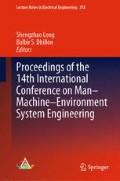Abstract
In view of the eye movement data to improve the bottom-up area calculation model, the modified artificial calculation model for calculation of psychological experiments before and after pictures of a significant area, psychology experiment and computer model calculation results by comparison and analysis of the eye movement data of significant influence and the reasons of the area calculation model, for the eye movement data significantly improved computer area calculation model and provides the interpretation of the psychology. The results showed that the eye movement data improved significantly the area calculation model more in line with the human visual system characteristics. Significant area calculation model of recognition effect is improved obviously.
Access this chapter
Tax calculation will be finalised at checkout
Purchases are for personal use only
References
Nurmi D, Wolski R, Grzego rczyk C et al (2008) Eucalyptus: a technical report on an elastic utility computing architecture linking your programs to useful systems. UCSB Computer Science, California
Siebenlist F (2009) Challenges and opportunities for virtualized security in the clouds. In: Proceedings of the 14th ACM symposium on access control models and technologies, SACMAT. 09. ACM, New York, USA, pp 1–2
Clark C, Fraser K, Hand S et al (2005) Live migration of virtual machines. In: Proceedings of NSDI. 05. Berkeley, CA, USA, pp 273–286
Theeuwes J (1991) Cross-dimensional perceptual selectivity. Percept Psychophys 50(2):184–193
Folk CL, Remington RW, Johnston JC (1992) Involuntary covert orienting is contingent on attentional control settings. J Exp Psychol Hum Percept Perform 18(4):1030–1044
Müller HJ, Heller D, Ziegler J (1995) Visual search for singleton feature targets within and across feature dimensions. Percept Psychophys 57(1):1–17
Kawahara J-I (2010) Identifying a “default” visual search mode with operant conditioning. Acta Psychol 135:38–49
Author information
Authors and Affiliations
Corresponding author
Editor information
Editors and Affiliations
Rights and permissions
Copyright information
© 2015 Springer-Verlag Berlin Heidelberg
About this paper
Cite this paper
Bai, Y., Yang, M., He, Y., Luo, Y., Huang, G. (2015). Study on Impact Analysis of Eye Movement Data to the Bottom-Up Significant Area Calculation Model. In: Long, S., Dhillon, B.S. (eds) Proceedings of the 14th International Conference on Man–Machine–Environment System Engineering. MMESE 2014. Lecture Notes in Electrical Engineering, vol 318. Springer, Berlin, Heidelberg. https://doi.org/10.1007/978-3-662-44067-4_27
Download citation
DOI: https://doi.org/10.1007/978-3-662-44067-4_27
Publisher Name: Springer, Berlin, Heidelberg
Print ISBN: 978-3-662-44066-7
Online ISBN: 978-3-662-44067-4
eBook Packages: EngineeringEngineering (R0)

